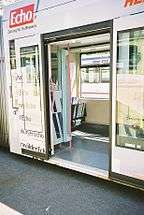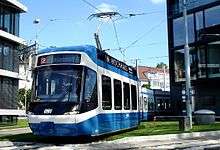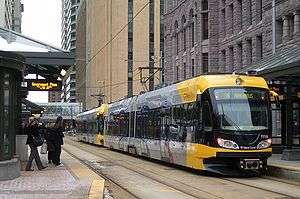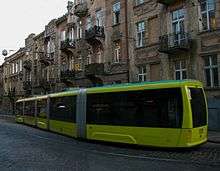Low-floor tram

A low-floor tram is a tram that has no stairsteps between one or more entrances and part or all of the passenger cabin. The low-floor design improves the accessibility of the tram for the public, and also may provide larger windows and more airspace.[1]
An accessible platform-level floor in a tram can be achieved either by using a high-floor vehicle serving high-platform tram stops, or with a true low-floor vehicle interfacing with curb level stops.
Currently both types are in use, depending on the station platform infrastructure in existing rail systems. Some systems may make use of former railway alignments where use of existing high platforms is desirable, while others, particularly new systems, may not have the space to site high-level stops in urban centres.
Low-floor tram configurations


Trams traditionally had high floors, and these designs evolved into the tram with a low-floor centre section. Examples of this design are Amsterdam 11g/12g-trams and the Kusttrams in Belgium.
The most common design of 100% low floor vehicles uses short carbody sections for the wheels and longer suspended sections. Examples of this are the Citadis and Combino. A similar, but somewhat older technique is one that has been developed by MAN. In 1990, it was the first 100% low floor tram. These trams are found in ten German cities (such as Bremen and Munich) and in the Swedish city Norrköping. In many other German cities there are trams with low floor between the outer bogies and single axle bogies under the centre section.
"Light rail" type vehicles frequently have a similar configuration but with a centre bogie designed to accommodate a low floor situated under a short centre section. A more radical approach has been adopted for the City Class LRV (Citytram), where the main low floor section is only 300 mm above the rail. The low floor runs right through the articulation of both the 29 m long and 38 m Super Citytram version. In both, the corridor through the articulation is wide enough for seated passengers and a wheelchair to pass through. The City Class has been designed to turn on 15 m radius curves and to climb 10% gradients.
In Austria, the Porsche designed Ultra Low Floor (ULF) Trams can "kneel" at the curbside, reducing the height from the road to only 180 mm.
Some public transport companies have both low floor and high floor trams. They report that low floor trams have 15% higher maintenance costs for the rolling stock, and 20% higher maintenance costs for the infrastructure on average.[2] Among the problems observed is that the missing bogies result in a higher level of wear and tear.
Many low floor trams have fixed bogies[3] which increase track wear and tear, while decreasing the speed at which a tram can drive through a curve (usually 4–15 km/h in 20 m radius curve).[4] The Škoda ForCity and the newest Alstom Citadis X04 try to counter the effect with low floor pivoting bogies while maintaining 100% low floor design. Prior to the new design, pivoting bogies could only be used under high floors, hence such trams could only be part low-floor, with high-floor sections over the pivoting bogies.
Historic examples
The idea of a low-floor tram is not new. A number of trolley systems beginning in the early 20th century experimented with various "stepless" designs. Perhaps the most notable is the Hedley-Doyle Stepless car introduced in 1912 for use on Broadway in Manhattan.[5] A number of other cities also purchased Hedley-Doyle Stepless trams after seeing their success in Manhattan. Since these cars had a unique appearance compared to any other trams running at the time, they earned a number of nicknames, including hobble skirt cars, public welfare cars, and sow bellies.[6]
Typical floor heights
To put things into perspective, here are some typical floor heights for public transport vehicles, old and new:
- Ultra Low Floor tram — 180 mm (7 inches)
- Low-floor tram — 300 mm to 350 mm (11.8 to 13.78 inches)
- High-floor tram — more than 600 mm (23.62 inches)
- Heavy rail rapid transit — 800 mm (31.5 inches) to 1200 mm (47.25 inches)
- North American inter-city rail passenger cars — 1350 mm (51 inches)
List of low-floor trams by contry manufactured and manufacturers

Belarus
- AKSM-743 - Third Generation tram on Minsk tramway
- AKSM-843 - Fourth generation tram on Minsk tramway
Canada


.jpg)

- Bombardier Transportation (are subtypes and more)
- A32 Flexity Swift
- Citytram
- Cobra
- CR4000 Flexity Swift
- GT8-100D/2S-M
- ET 2010 Flexity Swift (Tram-train)
- E-class Melbourne tram Flexity Swift
- Flexity 2
- Flexity 2 (version for Blackpool)
- Flexity Berlin (Incentro family)
- Flexity Classic
- Flexity Freedom
- Flexity Link
- Flexity Outlook Eurotram
- Flexity Outlook Cityrunner
- Flexity Outlook Olympic Line
- Flexity Outlook (version for Toronto)
- GT8-100D/2S-M
- HF6 Flexity Swift (not low-floor, but due to the high platform is wheelchair access)
- Incentro
- Incentro AT6/5 (version for Nottingham)
- K4000 Flexity Swift
- K4500 Flexity Swift
- K5000 Flexity Swift (not low-floor, but due to the high platform is wheelchair access)
- K5200 Flexity Swift (not low-floor, but due to the high platform is wheelchair access)
- M5000 Flexity Swift (not low-floor, but due to the high platform is wheelchair access)
- Traintram Flexity Swift
- Type 1 LVR Flexity Swift
- T2000
- Variotram
Croatia
- TMK 2200 (NT 2200)
- TMK 2200 K
- TMK 2300
Czech Republic
- K3R-N (reconstruction with low-floor middle article)
- K3R-NT (reconstruction with low-floor middle article)
- KT8D5N (reconstruction with low-floor middle article)
- KT8D5R.N1 (reconstruction with low-floor middle article)
- KT8D5R.N2 (reconstruction with low-floor middle article)
- KT8D5R.N2P (reconstruction with low-floor middle article)
- KTNF6 (reconstruction with low-floor middle article)
- KTNF8 (reconstruction with low-floor middle article)
- RT6N1
- RT6N2
- RT6S
- Satra III (reconstruction with low-floor middle article)
- Aliance TW Team

- Tatra T3R.PLF (nicknamed "wana" (in Czech language bath) - newly built with low-floor middle section)
- Tatra T3R.SLF ("wana")
- VarioLF ("wana")
- VarioLF plus ("wana")
- VarioLF plus/o ("wana")
- VarioLF2
- VarioLF2 plus
- VarioLF2/2 IN
- VarioLF3
- VarioLF3/2
- EVO1
- EVO2
- VV60LF (tow tramcar)
- 03T Astra/Anitra/Elektra
- 05T Vektra
- 06T Elektra
- 10T Elektra
- 13T Elektra
- 14T Elektra
- 15T ForCity Alfa
- 16T Elektra
- 19T Elektra
- 26T ForCity Classic
- 27T
- 28T ForCity Classic
- 29T ForCity Plus
- 30T ForCity Plus
- Artic ForCity Smart
France

_-_2.jpg)

- ATM Class 6000
- Citadis 100
- Citadis 202 (on Melbourne tramway locally designated C-class)
- Citadis 301
- Citadis 301 CIS numbers: 71-801.
- Citadis 302 (on Melbourne tramway locally designated C2-class)
- Citadis 401
- Citadis 402
- Citadis 403
- Citadis 502
- Citadis X-04 (204, 304, 404)
- Citadis X-05 (205, 305, 405)
- Regio-Citadis
- Citadis Dualis
- Citadis Compact
- Citadis Spirit
- Tatra KTNF8 in Gera
- Tramway Français Standard (TFS)-1 (low-floor added at a later date)
- TFS-2
- Translohr vehicles
- TW 2000 (not low-floor, but due to the high platform is wheelchair access)
Germany
- ATAC Class 9000

_GT8N_222_an_der_Hornusstra%C3%9Fe..jpg)

- Düwag-Vevey Be 4/6
- Düwag-Vevey Be 4/8
- GT6-70D/N
- GT8-100C/2S
- GT8-100D/2S-M
- GT8N (reconstruction with low-floor middle article)
- GT8Z (reconstruction with 73% low-floor)
- GT10 NC-DU (reconstruction with low-floor middle article)
- MGT6D
- M8C (not low-floor, but due to the high platform is wheelchair access)
- M8C-NF (reconstruction with low-floor middle article)
- MGT6D
- Moderus Beta MF 01, MF 13, MF 14 AC BD, MF 18 (reconstruction with low-floor middle article)
- M97 (reconstruction with low-floor middle article)
- N8C (not low-floor, but due to the high platform is wheelchair access)
- Stadtbahnwagen B (not low-floor, but due to the high platform is wheelchair access)
- Supertram
- TW 6000 (not low-floor, but due to the high platform is wheelchair access)
- U2 (not low-floor, but due to the high platform is wheelchair access)
- U3 (not low-floor, but due to the high platform is wheelchair access)
- U4 (not low-floor, but due to the high platform is wheelchair access)
- 6MGT
- 8MGT

- N8C (not low-floor, but due to the high platform is wheelchair access)
- N8S-NF (reconstruction with low-floor middle article)
.jpg)
- Avenio (on Munich tramway locally designated class T1)
- Combino (on Melbourne tramway locally designated D1-class and D2-class)
- Combino Plus (also known as Combino Supra or Combino MkII)
- GT6-70D/N
- GT8-70D/N
- GT8-100D/2S-M
- N8C (not low-floor, but due to the high platform is wheelchair access)
- Supertram
- S70
- SD-160 in platform level version (not low-floor, but due to the high platform is wheelchair access)
- S200 (not low-floor, but due to the high platform is wheelchair access)
- SD-400 (not low-floor, but due to the high platform is wheelchair access)
- SD-460 (not low-floor, but due to the high platform is wheelchair access)
- Stadtbahnwagen B (not low-floor, but due to the high platform is wheelchair access)
- TW 2000 (not low-floor, but due to the high platform is wheelchair access)
- Ultra Low Floor (ULF) in Vienna
- U2 (not low-floor, but due to the high platform is wheelchair access)
- U3 (not low-floor, but due to the high platform is wheelchair access)
- U4 (not low-floor, but due to the high platform is wheelchair access)
- Eurotram (on Milan tramway locally designated as Class 7000)
- GTxN/M/S (on Munich tramway locally designated classes R2 and R3)
- GT6-70D/N
- GT8-70D/N
- GT8-100D/2S-M
- N8C (not low-floor, but due to the high platform is wheelchair access)
- Variobahn
- GTZ8-B Vamos (not low-floor, but due to the high platform is wheelchair access)
- N8C (not low-floor, but due to the high platform is wheelchair access)
- Stadtbahnwagen B
Italy
- ATM Class 5000
- ATM Class 7100 (family Sirio)
- ATM Class 7500 (family Sirio)
- ATM Class 7600 (family Sirio)
- M32 trams on Gothenburg tramway (family Sirio)
- TEB serie 001-014 on Bergamo–Albino light rail
- SL95
- T-68 (not low-floor, but due to the high platform is wheelchair access)
- T-68A (not low-floor, but due to the high platform is wheelchair access)
- T-69

- ATM Class 5000
- ATM Class 6000
- ATAC Class 9100
- ATAC Class 9200
- ATAC Class 9000
- Eurotram (on Milan tramway locally designated as Class 7000)
Japan

- Alna Sharyo
- Little Dancer Type A
- Little Dancer Type C
- Little Dancer Type L
- Little Dancer Type S
- Little Dancer Type U
- Little Dancer Type Ua

Poland
- Konstal 112N
- Konstal 114Na
- Konstal 116N/116Na
- Konstal NGd99
- Konstal 116Nd
- Modertrans
.jpg)
- Moderus Beta MF 01, MF 13, MF 14 AC BD, MF 18 (reconstruction with low-floor middle article)
- Moderus Beta MF 02 AC, MF 15 AC, MF 16 AC BD, MF 19 AC (reconstruction with low-floor middle article)

- 120N Tramicus
- 120Na Swing
- 121N Tramicus
- 121Na Swing
- 122N Tramicus
- 122Na Swing
- 128N Jazz
- 128NG Jazz
- 134N Jazz
- 2010N Twist
- 2012N Twist Step
- 2014N Twist Krakowiak
- 71-414 Twist Fokstrot
- Protram 204 WrAs
- Protram 205 WrAs
- Protram 206 WrAs - In project phase
- Solaris Tramino
Ukraine

- Electron T3L44 (experimental)
- Electron T5L64 (experimental)
- Electron T5B65
Spain

- Urbos 1
- Urbos 2
- Urbos 3 - version Urbos 70
- Urbos 3 - version Urbos 100
- Urbos 3 - version Urbos AXL
- Urbos 3 - version Urbos TT
- Urbos 3 - version Urbos LRV
- British Rail Class 399 Citylink
- NET 2012
Switzerland
- GT8-100C/2S (not low-floor, but due to the high platform is wheelchair access)
- Tram 2000 Be 4/8 (low-floor middle article)
- Variobahn

- Tango (Model Bochum)
- Tango (Model Basel)
- Variobahn (on Munich tramway locally designated class S)
Russian Federation
.jpg)

- LVS-2005
- LVS-2008
- LVS-2009
- KTM-23 (71-623)
- KTM-24 (71-624)
- KTM-25 (71-625)
- KTM-30 (71-630)
- KTM-31 (71-631)
Other trams
- 71-911 City Star
- 71-931 Vityaz
- AKSM 843 (BKM 843)
- Siemens S70Konstal 116NAvanto (aka. Siemens S70)
- BKM 85300M
- DL6WA, mark Dalianren (meaning "Dalian people") manufactured by Tram Factory of Dalian, in Dalian.
- Boston MBTA Type 8 Trolley
- Bucur LF
- Cegielski 118N "Puma" (>60% low floor)
- City Class LRV
- Hedley-Doyle Stepless car (1912)[5]
- Imperio
- RTE 2009
- SEPTA PCC II (loading platform)
- Transtech Oy Artic Trams
- United Streetcar trams
- V3A-93-CH-PPC
- Tram 2000 Be 4/6 (not low-floor, but due to the high platform is wheelchair access)
- GTZ8-B Vamos
- HCP Puma
- M31 on Gothenburg tramway (reconstruction with low-floor middle article)
- Fukui Railway F1000 (ja福井鉄道F1000形電車)
- Hiroden 1000 series (II) (ja:広島電鉄1000形電車 (2代))
- Hiroden 5100 series ja:広島電鉄5100形電車)
- Kumamoto City Tram 0800 (ja:熊本市交通局0800形電車)
- Kumamoto City Tram 9700 series (ja:熊本市交通局9700形電車)
- Man'yosen MLRV 1000 (ja:万葉線MLRV1000形電車)
- Okayama Electric Tramway 9200 (ja:岡山電気軌道9200形電車)
- ja:SWIMO
- Toyama Chiho Railway 9000 series (ja:富山地方鉄道9000形電車)
- Toyama Light Rail TLR 0600 (ja:富山ライトレールTLR0600形電車)
- Newag Nevelo
- NGT6DD-ER on Dresden tramway
- Serie 3800 de FGV on Valencia tramway/CCFL fleet series 501-510 on Lisbon tramway
See also
References
- ↑ "The joy of high ceilings (also called low floors)". Human Transit. Retrieved 2010-02-22.
- ↑ Prof. Dr. Ing. Thomas Siefer (March 2010). "Abschlussbericht - Entwicklung des Stadtbahnnetzes Hannover - Studie zum Einsatz von Niederflurfahrzeugen" (PDF). Institut für Verkehrswesen, Eisenbahnbau und -betrieb (TU Braunschweig). p. 111. Retrieved 2012-02-18.
Eine weitere Erknenntnis der Unternehmem, die sowohl Hochflur-, als auch Niederflurfahrzeuge im Einsatz haben, ist der direkte Kostenvergleich beider Systeme. Für die Wartung und Instandhaltung der Fahrzeuge werden im Mittel Mehrkosten in Höhe von 20% genannt. Für die Wartung und Instandhaltung der Infrastruktur werden beim Einsatz von Niederflurfahrzeugen um 15% höhere Kosten ermittelt.
- ↑ "Zelingr, Heptner" (PDF). Retrieved 2010-05-12.
- ↑ "ČVUT.cz - Čapek, Kolář" (PDF). Retrieved 2010-05-12.
- 1 2 "A Novelty in Car Construction, The "Stepless" type of the New York Railways Company". Brill Magazine. J. G. Brill Company. VI (3): 73–84. 1912. Retrieved 2012-08-17.
- ↑ "San Diego Electric Railway San Diego Class I Electric Streetcar Bodies No. 126, 128 & 138" (PDF). pp. 24–25. Retrieved 2012-08-17.
External links
- Strassenbahn-Online (in German)